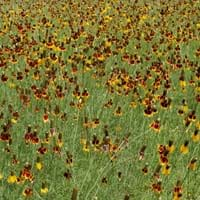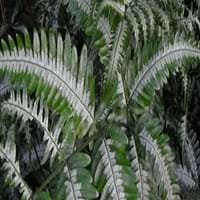Life Span
Perennial
Perennial
Origin
Southeastern United States, North-Central United States, Central United States, South-Central United States, Southwestern United States, Texas, Canada, Mexico
Central America, South America, Eastern Africa, Middle Africa, Southern Asia, Southeastern Asia
Types
Not Available
Pteris aberrans, Pteris abyssinica, Pteris actiniopteroides
Number of Varieties
Not Available
Habitat
Dry areas, Prairies, Rocky areas, rocky outcrops
Subtropical climates, Subtropical forests, Tropical regions
USDA Hardiness Zone
3-10
10-11
Sunset Zone
A1, A2, A3, H1, H2, 1a, 1b, 2a, 2b, 3a, 3b, 4, 5, 6, 7, 8, 9, 10, 11, 12, 13, 14, 15, 16, 17, 18, 19, 20, 21, 22, 23, 24
H1, H2, 24
Habit
Upright/Erect
Clump-Forming
Flower Color
Yellow, Purple, Burgundy, Light Green, Brown
Not Available
Flower Color Modifier
Bicolor
Bicolor
Fruit Color
Brown
Not Available
Leaf Color in Spring
Light Green, Gray Green
White, Green, Silver
Leaf Color in Summer
Light Green, Gray Green
White, Green, Silver
Leaf Color in Fall
Light Green, Gray Green
White, Green, Silver
Leaf Color in Winter
Light Green
White, Green, Silver
Leaf Shape
Subulate
Pinnate
Plant Season
Summer
Spring, Summer, Fall, Winter
Sunlight
Full Sun
Full Shade, Partial shade
Type of Soil
Loam, Sand
Loam, Sand
The pH of Soil
Neutral
Acidic, Neutral
Soil Drainage
Well drained
Average
Bloom Time
Late Spring, Early Summer, Summer, Late Summer
Not Available
Tolerances
Drought
Not Available
Where to Plant?
Ground
Container, Ground, Pot
How to Plant?
Seedlings
By dividing rhizomes, tubers, Spores
Plant Maintenance
Medium
Medium
Watering Requirements
Average Water Needs, Water in morning to avoid prompting diseases
Average Water Needs
In Summer
Lots of watering
Lots of watering
In Spring
Moderate
Moderate
In Winter
Average Water
Average Water
Soil pH
Neutral
Acidic, Neutral
Soil Type
Loam, Sand
Loam, Sand
Soil Drainage Capacity
Well drained
Average
Sun Exposure
Full Sun
Full Shade, Partial shade
Pruning
Cut or pinch the stems, Pinch Tips, Remove damaged leaves, Remove dead branches, Remove dead flowers, Remove dead leaves, Remove dead or diseased plant parts, Remove deadheads
Remove damaged leaves, Remove dead branches, Remove dead leaves, Remove dead or diseased plant parts
Fertilizers
All-Purpose Liquid Fertilizer, Apply N-P-K
All-Purpose Liquid Fertilizer
Pests and Diseases
Pests and diseases free, Red blotch
Red blotch
Plant Tolerance
Drought, Dry Conditions, Dry soil, Full Sun
Not Available
Flower Petal Number
Single
Single
Foliage Texture
Fine
Fine
Foliage Sheen
Matte
Matte
Attracts
Birds, Butterflies
Bees, Birds, Butterflies
Allergy
Rhinitis
Not Available
Aesthetic Uses
Borders
Hanging Basket, Showy Purposes
Beauty Benefits
Not Available
Not Available
Edible Uses
No
Insignificant
Environmental Uses
Air purification
Air purification
Medicinal Uses
Analgesic
Not Available
Part of Plant Used
Flowers
Not Available
Other Uses
Can be made into a herbal tea, Used in making tea
Showy Purposes
Used As Indoor Plant
No
No
Used As Outdoor Plant
Yes
Yes
Garden Design
Container, Cutflower, Mixed Border, Wildflower
Container, Feature Plant, Groundcover, Houseplant, Mixed Border, Tropical
Botanical Name
RATIBIDA columnifera
PTERIS argyraea
Common Name
Mexican Hat
Brake Fern
In Hindi
Mexican Hat
Brake Fern Plant
In German
Mexican Hat
Brems Farnanlage
In French
Mexican Hat
Brake Fern Plante
In Spanish
mexican Hat
Planta del helecho del freno
In Greek
Mexican Hat
Φρένο Fern Plant
In Portuguese
Mexican Hat
Brake Planta Fern
In Polish
Mexican Hat
Hamulec Fern roślin
In Latin
Mexicanus Hat
Fregit Fern Plant Families
Phylum
Tracheophyta
Tracheophyta
Class
Magnoliopsida
Polypodiopsida
Order
Asterales
Polypodiales
Family
Asteraceae
Pteridaceae
Clade
Angiosperms, Asterids, Eudicots
Not Available
Tribe
Not Available
Not Available
Subfamily
Not Available
Pteridoideae
Number of Species
Not Available
Season and Care of Mexican Hat and Brake Fern
Season and care of Mexican Hat and Brake Fern is important to know. While considering everything about Mexican Hat and Brake Fern Care, growing season is an essential factor. Mexican Hat season is Summer and Brake Fern season is Summer. The type of soil for Mexican Hat is Loam, Sand and for Brake Fern is Loam, Sand while the PH of soil for Mexican Hat is Neutral and for Brake Fern is Acidic, Neutral.
Mexican Hat and Brake Fern Physical Information
Mexican Hat and Brake Fern physical information is very important for comparison. Mexican Hat height is 30.00 cm and width 30.50 cm whereas Brake Fern height is 90.00 cm and width 60.00 cm. The color specification of Mexican Hat and Brake Fern are as follows:
Mexican Hat flower color: Yellow, Purple, Burgundy, Light Green and Brown
Mexican Hat leaf color: Light Green and Gray Green
Brake Fern flower color: Not Available
- Brake Fern leaf color: White, Green and Silver
Care of Mexican Hat and Brake Fern
Care of Mexican Hat and Brake Fern include pruning, fertilizers, watering etc. Mexican Hat pruning is done Cut or pinch the stems, Pinch Tips, Remove damaged leaves, Remove dead branches, Remove dead flowers, Remove dead leaves, Remove dead or diseased plant parts and Remove deadheads and Brake Fern pruning is done Remove damaged leaves, Remove dead branches, Remove dead leaves and Remove dead or diseased plant parts. In summer Mexican Hat needs Lots of watering and in winter, it needs Average Water. Whereas, in summer Brake Fern needs Lots of watering and in winter, it needs Average Water.





